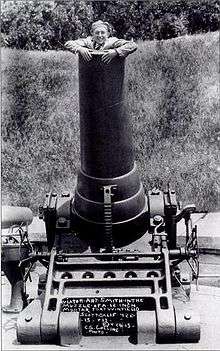Art Smith (pilot)
| Arthur Roy Smith | |
|---|---|
_1915.jpg) | |
| Born |
March 27, 1890 Fort Wayne, Indiana |
| Died |
February 12, 1926 (aged 35) Montpelier, Ohio |
| Cause of death | Aircrash |
| Spouse(s) | Aimee Cour |
| Parent(s) |
James F. Smith Ida Krick |

Arthur Roy Smith (February 27, 1890 – February 12, 1926) was an American pilot. After Charles Ames, he was the second overnight mail service pilot to die on duty.[1]
Early life and career
He was born on February 27, 1890 in Fort Wayne, Indiana to James F. Smith and Ida Krick.
In 1910, his parents mortgaged their home for $1,800 so that he could build a plane, on which he spent six months; however, he crashed it on his first flight, destroying everything but the motor.[1] However, he quickly became a celebrated stunt pilot, notable for flying at night; he was one of the pioneers of skywriting at night using flares attached to his aircraft. Katherine Stinson, one of America's first female stunt pilots, was inspired to compete against him by this feat, and the competition between her, Smith, and other men received widespread press coverage.[2]
On May 14, 1915, fellow aviator Lincoln Beachey, who was the official stunt flyer at the Panama-Pacific International Exposition in San Francisco, died after crashing into the bay. Art Smith (who was racing his "Baby Cars" at the fair) was hired to take Beachey's place and flew his airplane for spectators for the duration of the exposition.[3]
Smith made two trips to Asia, in 1916 and 1917; his aerobatics demonstrations in Korea during those trips are believed to have inspired both An Chang-nam (Korea's first male pilot) and Kwon Ki-ok (Korea's first female pilot) to learn to fly.[4][5][6]
During World War I
Smith later worked as a test pilot and instructor after the American entry into World War I; he had originally sought to enroll in the United States Army's Air Service, but was refused. His height (5 feet 3 inches) was mentioned as one possible reason for the refusal; the numerous injuries he had suffered in earlier crashes were another.[6][7] During the war, he was stationed at Langley Field, Virginia and McCook Field, Ohio; he was one of two men trained to fly the De Bothezat helicopter, an early quadrotor helicopter.[6]
Airmail Service
After the war, he joined the United States Post Office; he eventually came to fly the overnight airmail delivery route between New York City and Chicago, established in July 1925. He died February 12, 1926 near Montpelier, Ohio; he was two miles off-course when he crashed a Curtiss Carrier Pigeon[8][9] into a grove of trees while flying east.
Legacy
Fort Wayne's Smith Field is named after him.[10]
Smith would unknowingly contribute to the foundation of Honda when during Smith's tour of Asia in 1917, a young Japanese bicycle mechanic named Soichiro Honda rode twenty miles from his home hoping to see Smith demonstrate his aerial capabilities along with seeing an airplane in flight for the very first time. Although he could not afford the admission fee, seeing Smith in flight from a tree was a moment that left a deep impression on a young Soichiro Honda and cemented his interest in mechanical objects, with Soichiro's interest in mechanics and motorized vehicles leading to the creation of the eponymous company bearing his name.
References
- 1 2 "Pilot Smith". Time. 1926-02-22. Retrieved 2012-04-01.
- ↑ Lebow, Eileen (2004). Before Amelia: Women Pilots in the Early Days of Aviation. Brassey's. p. 189. ISBN 1884995446.
- ↑ Smith, James (2002). San Francisco's Lost Landmarks. Linden. p. 244. ISBN 1-57488-532-4.https://books.google.com/books?id=kzrE2fXazUAC&pg=PT236&lpg=PT236&dq=%22art+smith%22+%22lincoln+beachey%22+replaced+1915&source=bl&ots=7InCq7C7ra&sig=xW5Tq4hejnmjXcqB5bV_Ot7-gb8&hl=en&sa=X&ei=_coQVP6GOOGgigKFj4CwDg&ved=0CBcQ6AEwAQ#v=onepage&q=%22art%20smith%22%20%22lincoln%20beachey%22%20replaced%201915&f=false
- ↑ Min, Gyeong-myeong (2002-12-13). "우리나라 상공 날은 한국인 최초의 비행사, 언론학자에 의해 새로 태어난 안창남 (An Chang-nam, the first Korean pilot to fly in our country's skies, born again in the discussions of scholars)". Chungcheong Review. Retrieved 2007-05-22.
- ↑ "우리나라 최초의 여류비행사, 권기옥을 말한다 (Discussing Kwon Ki-ok, our country's first female aviator)". Republic of Korea Air Force. Retrieved 2007-05-21.
- 1 2 3 Roberts, Rachel Sherwood (2003). Art Smith: Pioneer Aviator. McFarland. ISBN 0-7864-1646-7.
- ↑ Bowen, Robert W. (2005). San Francisco's Presidio. Arcadia Publishing. p. 62. ISBN 0-7385-2986-9.
- ↑ "FATALITIES IN THE LINE OF DUTY". Air Mail Pioneers. Retrieved April 19, 2012.
- ↑ "Arago: Employees". Smithsonian Institution. Retrieved April 19, 2012.
- ↑ Cirrus ABS. "Airport History, Paul Baer, Art Smith : Smith Field Airport". Fort Wayne, Indiana: Fort Wayne Allen County Airport Authority. Retrieved April 19, 2012.